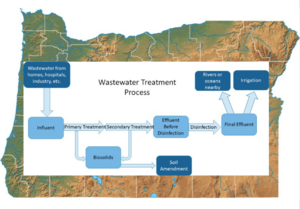
Wastewater from hospitals, residential homes, agriculture, and industry sources carry pollutants that can pose a health threat to humans. Possible pollutants include high ammonia concentrations and increased measurements of chemical oxygen demand (COD). If consumed, ammonia becomes dangerous because it can cause internal organ damage. COD is a measure of the amount of consumable oxygen in reaction with bacteria and chemicals, which reduces habitability for aquatic life. In an attempt to prevent these detrimental effects, pollutants are removed from wastewater in wastewater treatment plants (WWTPs) through filtration and biological treatment methods. From there, the treated wastewater is safely released back into the environment where it can be used for irrigation, recreation, and indirect human consumption. However, not all treated wastewater is completely safe from contamination. Even after filtration and treatment, there is a chance that concentrations of ammonia, solids, and COD are still present in the water. In order to further understand the trends of these properties, this project collects wastewater samples from 17 different WWTPs across Oregon, which is split into two regions: Eastern Oregon and the Coastal/Willamette Valley region. Samples collected from each WWTP include influent (the raw wastewater entering the treatment plant), secondary (after biological treatment), effluent (after disinfection and before release into the environment), and biosolids. These samples were specifically chosen to model the progressive removal of each pollutant as it travels through a WWTP. After data collection is completed, the effects of geographical and seasonal variations on the physical and chemical parameters of wastewater will be analyzed. The physical and chemical properties being examined for each sample includes pH, conductivity, COD, ammonia concentration, and total/volatile solids. Sampling takes place during the summer and winter seasons for a total of two years to observe the effects of climate on wastewater properties. Upon completion of the current study, the impact of these unique physical/chemical parameters and seasonal/geographical variations on the prevalence of antibiotic resistance of E.coli in wastewater will be examined.
